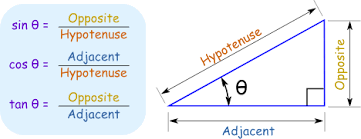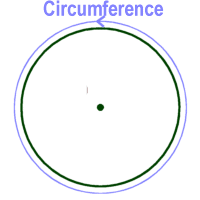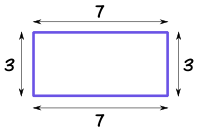Topics in Mathematics
Angles: Type of angles based on degree measurement Angle Pairs: Types of angle pairs Conversion of Number Bases explained with examples Angles: What are Angles? Categories of Angles Lines and Types in Mathematics Number Base System - Table showing the Number Bases with explanations Mathematics Scheme of Work, SS1, 3rd Term Mathematics Scheme of Work, SS1, 2nd Term Mathematics Scheme of Work, SS1, 1st Term Trigonometry - Sine, Cosine and Tangent explained with worked examples Quadratic Equation - Factorization of Quadratic Equation Algebra - Explanation and Worked Examples on AlgebraAcademic Questions in Mathematics

What type of polygon is shown in the above image?
A. Nonagon
B. Decagon
C. Octagon
D. Hexagon
E. Hepagon
F. Pentagon
Which of the following is not part of a circle?
A. Section
B. Sector
C. Segment
D. Semicircle
E. Secant
F. Center

What angle is shown in the above image?
A. Complementary
B. Supplementary
C. Acute
D. Obtuse
E. Reflex
F. Straight
An angle greater than 90o but less than 180o is termed _____.
A. Complementary
B. Supplementary
C. Acute
D. Obtuse
E. Reflex
F. Straight
Factorize 12a2 - 20a + 3
A. (6a - 1)(2a - 3)
B. (6a - 1)(2a + 3)
C. (6a + 1)(2a - 3)
D. (6a + 1)(2a + 3)
E. (-6a + 1)(2a - 3)
F. (-6a + 1)(2a + 3)
Simplify 10ab + 7ab
A. 17ab2
B. 17a2b2
C. 3ab2
D. 3a2b2
E. 17ab
F 3ab
Which of the following is not a type of angle?
A. Right angle
B. Left Angle
C. Acute Angle
D. Complete Angle
E. Straight Angle
F. Reflex angle
Two lines that can never meet each other are best considered as _____ lines.
Lines are quite important in mathematics because having a good understanding of them would help students to better understanding angles.
Please read on Angles and Types of Angles here.
Every form of line must begin from a point. In fact, a line can only be drawn within two different points. You can think of a point as a location. It has no length, depth or width. It is generally represented as a dot.
Note: A point is not necessarily a dot. A dot shows you where the point (location) really is.
As an instance, Below are five different points represented by a dot.
. . . . .
A line can be defined as the path between two points.
A line usually have a length but may have no width.
Lines are generally put into two categories in mathematics. Every other type of line will lie within these 2.
The two categories of lines are straight lines and curved lines.
Please read on the types of Line in technical drawings here.
When the path between two points are straight, then the line that is associated with the path is a straight line.
A straight line can be drawn in any direction. It could go from north to south or east to west.
The image below shows a straight line running from east to west.
EAST ______________________ WEST
Below are types of straight line:
A horizontal line is a line that runs from left to right or east to west in a straight line.
A vertical line runs from top to bottom or north to south in a straight line.
The word perpendicular simply means “at right angles”.
Two lines are said to be perpendicular if they meet or cross each other at a right angle.
Note: A right angle is an angle at ninety degrees (90o).

In the diagram above, you will observe that the line CD meets line AB at point E, which is at a right angle (90o). Line CD is therefore said to be perpendicular to line AB at point E.
Note the following from the above diagram:
Two lines are considered to be parallel if they will never meet each other, no matter the length at which you extend them.
The diagram below show two parallel lines:

Oblique lines are neither perpendicular nor parallel. They are slanted or tilted lines that will finally meet at some point, but not at a right angle (90o).

From the diagram above, the lines in:
Note: Oblique lines are sometimes referred to as slanting lines.

When the path between two lines isn’t straight, then such line can be said to be curved. Below is a curved line.
Kindly share this article via the links below:

Please click here to contact Alfred if you require any of the following services:
If you need a standard website at an affordable price.
Online training on the academic subjects: biology, chemistry and basic science.
If you require an advanced smart school management system (web application) for your school.
Click here to read on Len Academy Smart School Software.
Please click here to follow Len Academy on Google News.
Amazing facts in Mathematics
The opposite sides of a dice will always give a sum of seven
31,556,926 seconds makes one year
From 0 through 1000, the only number that has the letter 'a' in it is 'one thousand'
÷
The division symbol '÷' is actually called an obelus
Four is the only number in the English language that is spelt with the same number of letters as the number (4) itself
40 is spelt as forty and not 'fourty'. It is the only number that is spelt with letters arranged in alphabetical order
An odd number is a number that cannot be divisible by 2.
Every odd number has an 'e' in its spelling. They include:
555 in Thailand sounds like 'hahaha'. This is because the number '5' means 'ha' in Thailand
In mathematics, 10! means 10 factorial. Below is its calculation:
10! = 10 x 9 x 8 x 7 x 6 x 5 x 4 x 3 x 2 x 1 = 3628800
Interestingly, 3628800 seconds is the same as 42 days
42 days is the same as 6 weeks
We can therefore say that 10! equals 6 weeks or 3628800 seconds in mathematics
When you multiply 111,111,111 by 111,111,111; the result equals 12,345,678,987,654,321
Notable points in Mathematics
Let's use algebra to explain the simple statement below:
I am a number. When you subtract 3 from me, the result is 9. what number am I ?
Of course we know the answer is 12. You probably guessed it from your mind because it was that simple. The truth is, We could have a much more complicated statement of such; and that is where algebra comes into play.
Now, to apply algebra in the above statement, we use letters or alphabets to represent the unknown number(s). So using algebra, we can write:
Let the number be y
y - 3 = 9
y = 9 + 3
y = 12

The image above shows a right angled triangle. The angle of the above right triangle is denoted as θ. Below are some points to note:
Hypotenuse is always the longest side of the triangle.
Opposite is the side opposite the angle (θ)
Adjacent is the shorter side next to the angle (θ)
Each of Sin θ, cos θ and tan θ are the ratio of sides of the right triangle. They are calculated by using the formula (margic word) sohcahtoa:

soh
Sin θ = Opposite/Hypotenuse
cah
Cos θ = Adjacent/Hypotenuse
toa
Tan θ = Opposite/Adjacent

Circumference in mathematics means the distance around the edge of a circle (or a another curved surface).
Circumference is to circle or any other curved surface

Perimeter means the distance around a square or rectangle or polygon.
Perimeter is to square or rectangle or polygon